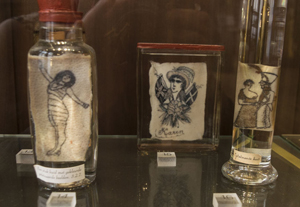Tattoos

This piece of human skin with the image of a soldier courting a woman is one of the oldest tattoos in the museum’s collection. It dates back to the end of the eighteenth century, a time where adornments such as these were still exceptional. It has been conserved in formaldehyde by anatomist Pieter de Riemer.
Tattoos have been around in many cultures and for many ages. Even the 5000-year-old ice mummy Ötzi had them. However, they had a questionable reputation in Western Europe. In classical antiquity Greeks and Romans used tattoos to mark slaves and criminals. Only after James Cook visited Tahiti in 1769 did tattooing become popular again. There’s good reason for the fact that the word ‘tattoo’ has been derived from the Tahitian ‘tattau’ which means ‘to beat’.
In those early days mostly sailors and miners decorated their bodies. The sailors often chose an anchor, the miners a lamp – as a kind of amulet. Later on, other symbols became popular, such as the compass rose. Poseidon, the Greek god of the sea, was the sign for someone who had crossed the equator.
By the end of the nineteenth century tattoos became popular among the higher classes. They counted as status symbol among the high society of London and New York.

